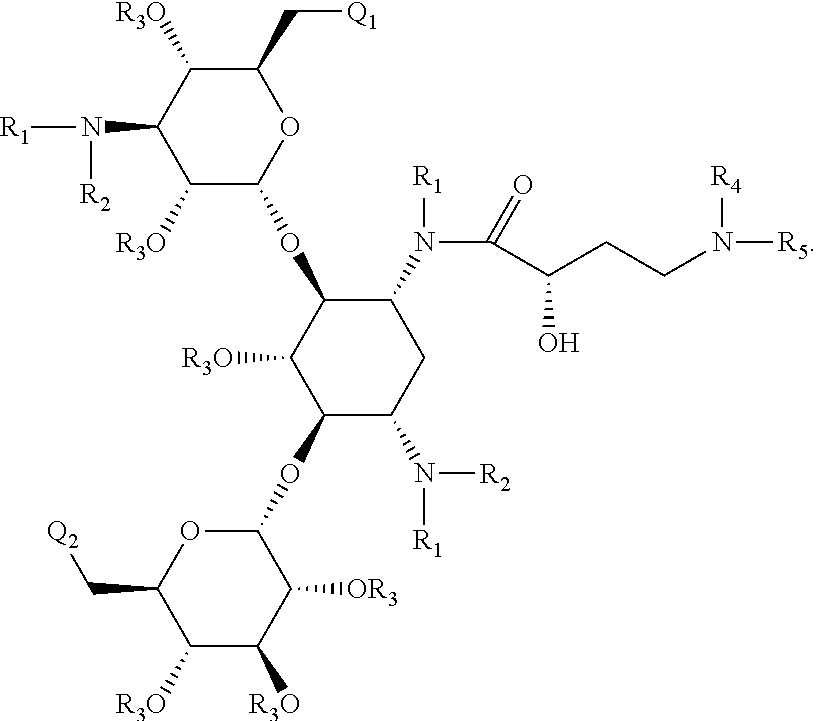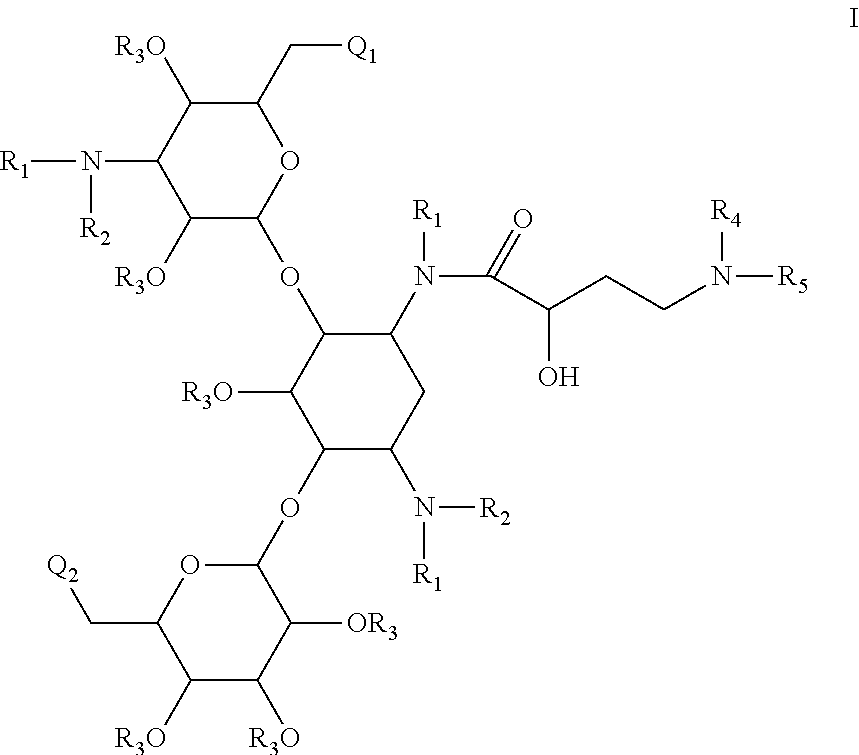Antibacterial 4,6-substituted 6', 6" and 1 modified aminoglycoside analogs
a technology of aminoglycosides and aminoglycosides, applied in the field of aminoglycoside compounds, can solve the problems of difficult to isolate and purify proteins, inability to use single alpha helixes or beta sheets in drug screening, and inability to remove single beta sheets or beta sheets and use them in drug screening. , to achieve the effect of limiting the reagent in high throughput screening efforts, the biologically active form of the protein can also be quite expensiv
- Summary
- Abstract
- Description
- Claims
- Application Information
AI Technical Summary
Problems solved by technology
Method used
Image
Examples
example 1
Preparation of 1-N-[4-(tert-butoxycarbonyl)amino-2-S-hydroxybutyryl]kanamycin A
[0082]
[0083]Amikacin sulfate 1.0 grams (Commercially available from a number of chemical companies: O.M. Chemical Co., Ltd., Shanghai, China; Zhejiang Winsun Imp. & Exp. Co., Ltd, Zhejiang, China; Ningbo DHY Pharmaceutical Co., Zhejiang, China; and Shanghai Xudong Haipu Pharmaceutical Co., Ltd, Shanghai, China) was treated with 4 grams of Amberlite ion exchange resin (OH— form, Aldrich, Milwaukee, Wis.) in 10 mL of water for 1 hour. The resultant solution was filtered and lyophilized to give Amikacin Free Base. The Amikacin free base (5.0 g, 8.5 mmoles) was dissolved in a mixture of 1,4-dioxane (165 mL) and H2O (235 mL). To this solution was added tert-butyloxycarbonyloxy-5-norbornene-2,3-dicarboxamide (1.3 g, 7.8 mmoles) dissolved in a mixture of CH2Cl2 (10 mL) and 1,4-dioxane (5 mL), over 50 min at room temperature. The reaction was stirred at room temp for 3 hours, and then evaporated under reduced pre...
example 2
Preparation of 6′-N-(benzyloxycarbonyl)-1-N-[4-(tert-butoxycarbonyl)amino-2-S-hydroxybutyryl]-kanamycin A
[0085]
[0086]1-N-[4-(tert-butoxycarbonyl)amino-2-S-hydroxybutyryl]kanamycin A (2.4 g, 3.5 mmoles) was dissolved in a mixture of 1,4-dioxane (9 mL) and water (9 mL) at room temperature. To this solution was added benzyloxycarbonyloxy-5-norbornene-2,3-dicarboxamide (1.0 g, 3.2 mmoles), dissolved in 1,4-dioxane (2 mL), over 20 minutes at room temperature. The reaction was stirred for 1 hour, and then evaporated under reduced pressure. The resultant solid was subjected to silica gel chromatography (6:2:1.5:0.5, CH2Cl2, MeOH, 1,4-dioxane, NH4OH, Rf=0.36) and then lyophilized to give the title compound 1.0 g (38%) as a white solid.
[0087]1H NMR (DMSO-d6 / D2O, 300 MHz) δ 7.4 (m, 5H), 5.04 (d, 1H, J=12.6 Hz), 4.96 (d, 1H, J=12.6 Hz), 4.96 (d, 1H, J=3.3 Hz), 4.88 (d, 1H, J=3.3 Hz), 3.83 (dd, 1H, J=9.3, 3.3 Hz), 3.8-3.6 (m, 5H), 3.6-3.35 (m, 7H), 3.35-2.8 (m, 10H), 1.85 (m, 1H), 1.88 (m, 1H),...
example 3
Preparation of 3,3″-N,N-di-(tert-butoxycarbonyl)-1-N-[4-(tert-butoxycarbonyl)-amino-2-S-hydroxybutyryl]kanamycin A
[0088]
[0089]6′-N-(Benzyloxycarbonyl)-1-N-[4-(tert-butoxycarbonyl)amino-2-S-hydroxybutyryl]-kanamycin A (0.99 g, 2.9 mmoles) was dissolved in 1,4-dioxane (15 mL) / H2O (5 mL) and then treated dropwise with di-tert-butyl dicarbonate (0.78 g, 3.6 mmoles) in 1,4-dioxane (3 mL) over 10 minutes at room temperature. The reaction was stirred for 16 hours and then evaporated to give a white solid. The solid was suspended in tert-butylmethylether (30 mL) and then decanted twice. The resultant solid (0.90 g, 73%) was used without further purification. TLC; (6:2:1.5:0.5, CH2Cl2, MeOH, 1,4-dioxane, NH4OH, Rf=0.42). A portion of this solid (780 mg, 0.77 mmoles) was treated with 10% Pd / C (70 mg) in 90% MeOH (60 mL) under a 10 psi H2 atmosphere for 3 hours to give a 93% yield of the title compound (627 mg) as the HCl salt.
PUM
| Property | Measurement | Unit |
|---|---|---|
| temperature | aaaaa | aaaaa |
| volume | aaaaa | aaaaa |
| molecular weight | aaaaa | aaaaa |
Abstract
Description
Claims
Application Information
 Login to View More
Login to View More - R&D
- Intellectual Property
- Life Sciences
- Materials
- Tech Scout
- Unparalleled Data Quality
- Higher Quality Content
- 60% Fewer Hallucinations
Browse by: Latest US Patents, China's latest patents, Technical Efficacy Thesaurus, Application Domain, Technology Topic, Popular Technical Reports.
© 2025 PatSnap. All rights reserved.Legal|Privacy policy|Modern Slavery Act Transparency Statement|Sitemap|About US| Contact US: help@patsnap.com



